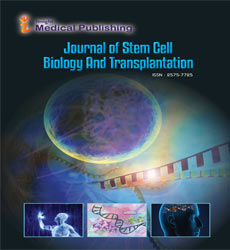Abstract
Early cancer screening and prophylactic immunotherapy A stem cell approach
Prevention is better than cure. This is more so applicable to inheritable Cancers, where a likely event could be predicted with close statistical probabilities. This study is an attempt that uses advanced prophylactic treatment options to look into the reduction in the frequency or statistical probability of development of cancer in the high risk group of female individuals with family history of BRCA1/2 mutations. Briefly, critical genetic insults and epigenetic alterations of somatic cell (or stem / progenitor cell) create primordial Tumor-initiating cell (TIC) with stem-cell like properties that in due course accumulate progressive genetic lesions that confers a growth and/or survival advantage over its normal counterparts, eventually developing into a full blown cancer. A cancer-initiating cell must survive long enough to accumulate three to seven genetic mutations necessary to generate cancer. Most terminally differentiated cells, even if they encounter mutations, are neither long-lived nor possess the ability to produce tumors with the limited number of divisions remaining in their differentiation program. In contrast, acquisition of longevity and extensive proliferative capacity of a somatic cell or a stem cell precursor make it an ideal candidate for cancer-initiating cell. Tumor initiating stem-like cells (TICs) are a small subset of precursor lesions which are capable of self-renewal and resistant to various chemotherapeutic drugs and radiation. This subpopulation behaves like stem cells by undergoing either asymmetric or symmetric cell division thereby maintaining its population. Generation of TICs is an extremely rare event, though is greatly propelled by any inheritable or germinal mutation, such as BRCA 1/2 mutations, that provides a mutagenic background for superimposition of further insults. Naturally, over 25-45% of breast cancer (BC) patients below 35 years of age have hereditary origin involving BRCA1/2 mutation. Similarly, 80% of the families with the history of Ovarian Cancer (OC) have BRCA1 mutation and 15% of them with BRCA2 mutation. BRCA1 mutation carriers have an 18% risk (15% for BRCA2 mutation carriers) for developing BC up to the age of 39 years, and the risk increases to 59% (BRCA2 - 34%) at ages 40–49 years. Such an overt association calls for prophylactic measures to prevent the likely development of cancer. In this study, we aim at using Autologous Immunotherapy involving Dendritic Cells (DCs), Natural Killer (NK) Cells and Lymphokine Activated Killer (NAK) cells primed with allogenous breast and ovarian cancer antigens as prophylactic measures to activate host immune system in the normal but BRCA1/2 mutation careers against the likely development of neoplastic lesions, whose development frequency is statistically predicted. Our objective here is to demonstrate the efficacy of the immunotherapeutic regimen in reducing the statistical probability of development of the breast and ovarian cancer in the test individuals.
Author(s): Anand Kumar Arachimani
Abstract | PDF
Share This Article
Google Scholar citation report
Citations : 80
Journal of Stem Cell Biology and Transplantation received 80 citations as per Google Scholar report
Abstracted/Indexed in
- Google Scholar
- Publons
- Euro Pub
Open Access Journals
- Aquaculture & Veterinary Science
- Chemistry & Chemical Sciences
- Clinical Sciences
- Engineering
- General Science
- Genetics & Molecular Biology
- Health Care & Nursing
- Immunology & Microbiology
- Materials Science
- Mathematics & Physics
- Medical Sciences
- Neurology & Psychiatry
- Oncology & Cancer Science
- Pharmaceutical Sciences

